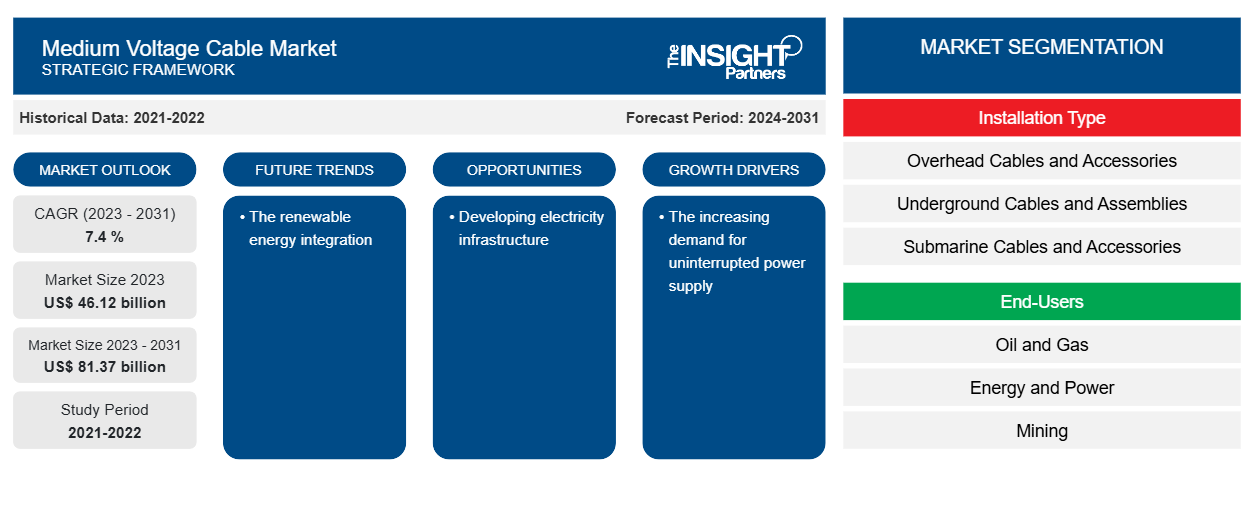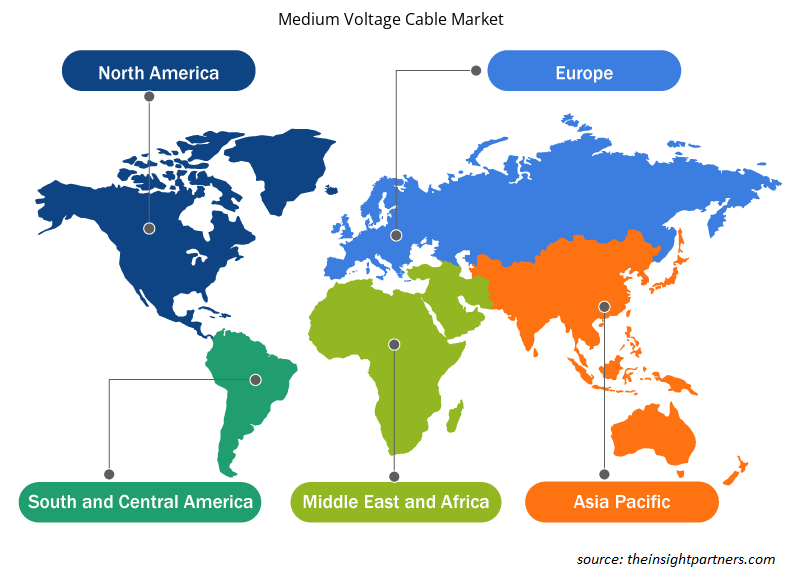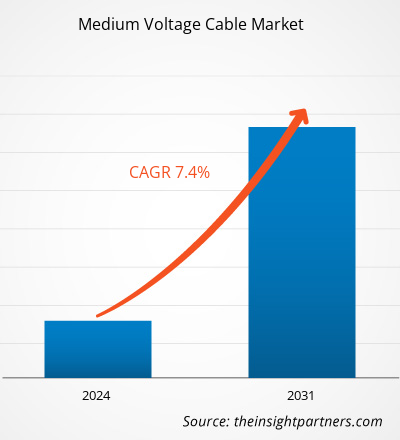Der Markt für Mittelspannungskabel wird voraussichtlich bis 2031 ein Volumen von 41,28 Milliarden US-Dollar erreichen, von 26,24 Milliarden US-Dollar im Jahr 2024. Für den Zeitraum 2025–2031 wird eine durchschnittliche jährliche Wachstumsrate (CAGR) von 6,9 % erwartet. Die zunehmende Weiterentwicklung der Kabeltechnologie dürfte in den kommenden Jahren neue Trends auf den Markt bringen.
Marktanalyse für Mittelspannungskabel
Steigender Energiebedarf, Infrastrukturausbau und die Umstellung auf erneuerbare Energien treiben die weltweite Nachfrage nach Mittelspannungskabeln an. Auch die zunehmende Bedeutung der Modernisierung von Stromnetzen zur Verbesserung von Effizienz und Zuverlässigkeit beschleunigt das Marktwachstum für Mittelspannungskabel . Die zunehmende Verbreitung von Smart-Grid-Technologie und Elektrofahrzeugen erfordert zudem eine zuverlässige Mittelspannungsinfrastruktur zur Energieverteilung. Technologische Fortschritte bei Kabelherstellungsprozessen und -materialien, wie beispielsweise die Isolierung aus vernetztem Polyethylen (XLPE), verbessern die Leistung und Langlebigkeit von Mittelspannungskabeln und machen sie für Energieversorger und Industriekunden attraktiver, was das Marktwachstum weiter vorantreibt.
Marktübersicht für Mittelspannungskabel
Mittelspannungskabel werden in Industriegebäuden, Projekten für erneuerbare Energien und Stromverteilungsnetzen eingesetzt. Sie ermöglichen längere Übertragungszeiten, geringere Energieverluste und höhere Zuverlässigkeit. Mittelspannungskabel sind seit langem fester Bestandteil moderner Stromverteilungssysteme. Sie gewährleisten eine effektive und zuverlässige Stromversorgung, die den täglichen Bedarf deckt, indem sie Strom von Umspannwerken zu verschiedenen Endpunkten wie Haushalten, Unternehmen und Industrieanlagen transportieren. Dieser Anstieg der Nachfrage ist darauf zurückzuführen, dass zahlreiche Branchen aufgrund von Urbanisierung, Industrialisierung, dem Ausbau erneuerbarer Energien und der Elektrifizierung des Verkehrswesens immer häufiger Mittelspannungskabel einsetzen.
Sie erhalten kostenlos Anpassungen an jedem Bericht, einschließlich Teilen dieses Berichts oder einer Analyse auf Länderebene, eines Excel-Datenpakets sowie tolle Angebote und Rabatte für Start-ups und Universitäten
Markt für Mittelspannungskabel: Strategische Einblicke

-
Informieren Sie sich über die wichtigsten Markttrends in diesem Bericht.Dieses KOSTENLOSE Beispiel umfasst Datenanalysen, von Markttrends bis hin zu Schätzungen und Prognosen.
Markttreiber und Chancen für Mittelspannungskabel
Wachsender Sektor für erneuerbare Energien
Bis Ende 2023 deckte sauberer, erneuerbarer Strom 43 % der weltweit installierten Stromkapazität. Dies stellt den größten Anstieg der grünen Kapazität dar und ist vor allem auf den starken Anstieg der Solar- und Windenergienutzung zurückzuführen. Mit der weltweit wachsenden Zahl von Projekten im Bereich erneuerbarer Energien steigt zudem der Bedarf an robusten Mittelspannungskabeln für den Anschluss von Stromerzeugungsanlagen an das Netz und die Stromverteilung an die Verbraucher. Da Länder zudem bestrebt sind, ihre Ziele für erneuerbare Energien zu erreichen und die CO2-Emissionen zu reduzieren, wird die Nachfrage nach effektiven Mittelspannungslösungen in den kommenden Jahren voraussichtlich steigen. Da zudem bereits Änderungen an der zugrunde liegenden Netzinfrastruktur im Gange sind, steigt die Nachfrage nach 11-kV-Mittelspannungskabeln international.
Innovation in der Set-Top-Box-Technologie (STB)
Die zunehmende Verbreitung von Elektrofahrzeugen (EVs) und der damit verbundene Ausbau der Ladeinfrastruktur eröffnen erhebliche Chancen für den Markt für Mittelspannungskabel. Da immer mehr Menschen und Unternehmen auf Elektrofahrzeuge umsteigen, steigt der Bedarf an einer zuverlässigen Stromversorgung von Ladestationen für Elektrofahrzeuge weiter an. Mittelspannungskabel sind entscheidend für den Anschluss der Ladeinfrastruktur an das Stromnetz, die Gewährleistung einer effizienten Energieübertragung und die Bewältigung der steigenden Belastung bestehender Stromnetze. Regierungen und Unternehmen investieren erheblich in Ladenetze für Elektrofahrzeuge, was voraussichtlich das Wachstum des Marktes für Mittelspannungskabel beflügeln wird.
Segmentierungsanalyse des Marktberichts für Mittelspannungskabel
Wichtige Segmente, die zur Ableitung der Marktanalyse für Mittelspannungskabel beigetragen haben, sind Installation, Spannung und Endbenutzer.
- Der Markt ist je nach Installation in Freileitungen, Erdleitungen und Unterwasserleitungen unterteilt. Das Freileitungssegment ist weiter unterteilt in aluminiumverstärkte Leiter mit Stahlverstärkung (ACSR), Leiter aus Aluminiumlegierungen (AAAC), aluminiumverstärkte Leiter mit Stahlverstärkung (AACSR) und weitere. Das Erdleitungssegment ist weiter unterteilt in vernetztes Polyethylen (XLPE), Polyvinylchlorid (PVC), papierisolierte Bleiummantelungen (PILC) und weitere. Das Freileitungssegment dominierte den Markt im Jahr 2024.
- Nach Spannung ist der Markt in 6 bis 13 KV, 23 KV, 34 KV, 45 KV, 69 KV und 1 bis 5 KV segmentiert. Das Segment 6 bis 13 KV dominierte den Markt im Jahr 2024.
- In Bezug auf die Endverbraucher wird der Markt in die Bereiche Industrie, Infrastruktur und erneuerbare Energien unterteilt. Das Industriesegment dominierte den Markt im Jahr 2024.
Marktanteilsanalyse für Mittelspannungskabel nach geografischer Lage
Der Markt für Mittelspannungskabel ist in fünf Hauptregionen unterteilt: Nordamerika, Europa, Asien-Pazifik, Naher Osten und Afrika (MEA) sowie Südamerika. Der asiatisch-pazifische Raum dominierte den Markt im Jahr 2024.
Im asiatisch-pazifischen Raum steigt die Nachfrage nach Mittelspannungskabeln aufgrund der rasanten Urbanisierung, Industrialisierung und des steigenden Energiebedarfs. Länder wie China und Indien treiben diesen Ausbau voran und investieren massiv in den Ausbau der Infrastruktur und in Projekte für erneuerbare Energien, um ihre boomenden Volkswirtschaften zu unterstützen. Die zunehmende Bedeutung von Smart-City-Projekten und die Modernisierung des Stromnetzes erhöhen die Nachfrage nach zuverlässigen Mittelspannungslösungen. Darüber hinaus bietet die zunehmende Nutzung von Elektrofahrzeugen (EVs) in Ländern wie Japan, Südkorea und Australien erhebliches Potenzial für Mittelspannungskabel zur Unterstützung der Ladeinfrastruktur. Staatliche Programme zur Förderung sauberer Energie und Nachhaltigkeit treiben die Branche ebenfalls an, da sie Investitionen in erneuerbare Energiequellen wie Solar- und Windkraft fördern, die effiziente Mittelspannungsleitungen erfordern.
Regionale Einblicke in den Markt für Mittelspannungskabel
Die Analysten von Insight Partners haben die regionalen Trends und Faktoren, die den Markt für Mittelspannungskabel im Prognosezeitraum beeinflussen, ausführlich erläutert. In diesem Abschnitt werden auch die Marktsegmente und die geografische Lage von Mittelspannungskabeln in Nordamerika, Europa, Asien-Pazifik, dem Nahen Osten und Afrika sowie Süd- und Mittelamerika erläutert.

- Erhalten Sie regionale Daten zum Markt für Mittelspannungskabel
Umfang des Marktberichts über Mittelspannungskabel
| Berichtsattribut | Details |
|---|---|
| Marktgröße im Jahr 2024 | 26,24 Milliarden US-Dollar |
| Marktgröße bis 2031 | 41,28 Milliarden US-Dollar |
| Globale CAGR (2025 – 2031) | 6,9 % |
| Historische Daten | 2021-2023 |
| Prognosezeitraum | 2025–2031 |
| Abgedeckte Segmente |
Nach Installation
|
| Abgedeckte Regionen und Länder |
Nordamerika
|
| Marktführer und wichtige Unternehmensprofile |
|
Marktteilnehmerdichte für Mittelspannungskabel: Auswirkungen auf die Geschäftsdynamik
Der Markt für Mittelspannungskabel wächst rasant. Die steigende Endverbrauchernachfrage ist auf Faktoren wie veränderte Verbraucherpräferenzen, technologische Fortschritte und ein stärkeres Bewusstsein für die Produktvorteile zurückzuführen. Mit der steigenden Nachfrage erweitern Unternehmen ihr Angebot, entwickeln Innovationen, um den Verbraucherbedürfnissen gerecht zu werden, und nutzen neue Trends, was das Marktwachstum weiter ankurbelt.
Die Marktteilnehmerdichte beschreibt die Verteilung der in einem bestimmten Markt oder einer bestimmten Branche tätigen Unternehmen. Sie gibt an, wie viele Wettbewerber (Marktteilnehmer) in einem bestimmten Marktraum im Verhältnis zu dessen Größe oder Gesamtmarktwert präsent sind.
Die wichtigsten Unternehmen auf dem Markt für Mittelspannungskabel sind:
- ABB Ltd
- Prysmian SpA
- Nexans SA
- TE Connectivity Ltd
- Southwire Company LLC
- Houston Wire & Cable Co.
Haftungsausschluss : Die oben aufgeführten Unternehmen sind nicht in einer bestimmten Reihenfolge aufgeführt.

- Überblick über die wichtigsten Akteure auf dem Markt für Mittelspannungskabel
Neuigkeiten und aktuelle Entwicklungen zum Markt für Mittelspannungskabel
Der Markt für Mittelspannungskabel wird durch die Erhebung qualitativer und quantitativer Daten aus Primär- und Sekundärforschung bewertet, die wichtige Unternehmenspublikationen, Verbandsdaten und Datenbanken umfasst. Nachfolgend sind einige Entwicklungen im Markt für Mittelspannungskabel aufgeführt:
- Amokabel gab die Einführung seines neuen Mittelspannungskabels bekannt. Bei der Entwicklung wurde besonderer Wert auf Nachhaltigkeit, Qualität und Flexibilität gelegt und die Produktion erfolgt zu 100 % mit erneuerbarer Energie. Das neue Kabel vereint hohe technische Leistung mit ökologischer Verantwortung.
(Quelle: Amokabel, Pressemitteilung, Mai 2025)
- NKT investiert in zusätzliche Produktionskapazitäten und -fähigkeiten in seinen Mittelspannungsfabriken in Dänemark, Schweden und der Tschechischen Republik, um der wachsenden Nachfrage der Kunden nach Mittelspannungskabeln gerecht zu werden, die für Netzmodernisierungen und Projekte im Bereich erneuerbare Energien in ganz Europa benötigt werden.
(Quelle: NKT, Pressemitteilung, April 2024)
Marktbericht zu Mittelspannungskabeln – Umfang und Ergebnisse
Der Bericht „Marktgröße und Prognose für Mittelspannungskabel (2021–2031)“ bietet eine detaillierte Analyse des Marktes, die die unten genannten Bereiche abdeckt:
- Marktgröße und Prognose für Mittelspannungskabel auf regionaler und Länderebene für alle wichtigen Marktsegmente, die im Rahmen des Geltungsbereichs abgedeckt sind
- Markttrends und Marktdynamiken für Mittelspannungskabel wie Treiber, Einschränkungen und wichtige Chancen
- Detaillierte PEST- und SWOT-Analyse
- Marktanalyse für Mittelspannungskabel mit wichtigen Markttrends, regionalen Rahmenbedingungen, wichtigen Akteuren, Vorschriften und jüngsten Marktentwicklungen
- Branchenlandschafts- und Wettbewerbsanalyse mit Marktkonzentration, Heatmap-Analyse, prominenten Akteuren und jüngsten Entwicklungen auf dem Markt für Mittelspannungskabel
- Detaillierte Firmenprofile
- Historische Analyse (2 Jahre), Basisjahr, Prognose (7 Jahre) mit CAGR
- PEST- und SWOT-Analyse
- Marktgröße Wert/Volumen – Global, Regional, Land
- Branchen- und Wettbewerbslandschaft
- Excel-Datensatz
Aktuelle Berichte
Verwandte Berichte
Erfahrungsberichte
Grund zum Kauf
- Fundierte Entscheidungsfindung
- Marktdynamik verstehen
- Wettbewerbsanalyse
- Kundeneinblicke
- Marktprognosen
- Risikominimierung
- Strategische Planung
- Investitionsbegründung
- Identifizierung neuer Märkte
- Verbesserung von Marketingstrategien
- Steigerung der Betriebseffizienz
- Anpassung an regulatorische Trends






















 Kostenlose Probe anfordern für - Markt für Mittelspannungskabel
Kostenlose Probe anfordern für - Markt für Mittelspannungskabel